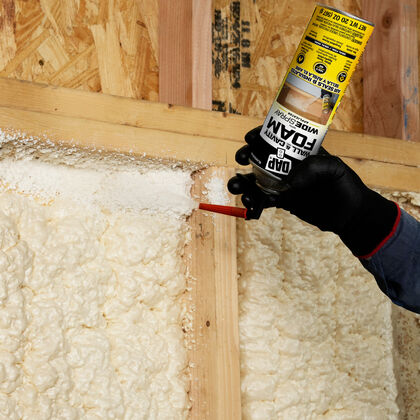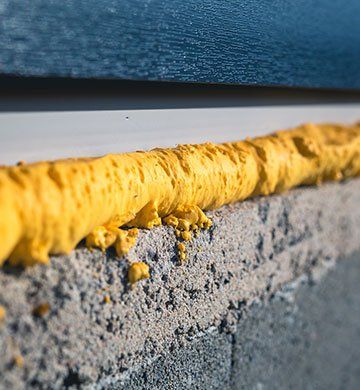The Process of Using Spray Foam: What You Required to Know
Spray Foam: The Ultimate Service for Air Sealing and Insulation
Spray foam insulation has actually arised as a leading option for effective air sealing and thermal insulation, using an one-of-a-kind combination of buildings that set it apart from traditional methods. Recognizing the complete range of its advantages, installment processes, and contrasts with various other insulation types is essential for making notified choices.
What Is Spray Foam?
Spray foam is a flexible insulation product that incorporates the concepts of air securing and thermal resistance to boost energy performance in buildings. Made up largely of polyurethane or other similar compounds, spray foam is used as a liquid that broadens upon call with surfaces, developing a solid, continual layer of insulation. This one-of-a-kind residential property permits it to fill gaps, cracks, and gaps that standard insulation products might overlook, giving a premium air seal.
There are two major types of spray foam: open-cell and closed-cell. Open-cell spray foam is lighter and extra adaptable, providing exceptional noise absorption and a reduced R-value per inch - Spray Foam. In contrast, closed-cell spray foam is denser, supplying a higher R-value, wetness resistance, and included structural integrity to developing parts
The application process usually includes customized tools, making certain a smooth application that abides by numerous substratums, consisting of wood, concrete, and metal. This versatility makes spray foam appropriate for both brand-new constructions and retrofitting existing structures. Its ability to develop an airtight barrier considerably adds to decreasing energy usage and improving interior air top quality, thus making it a favored choice amongst home builders and homeowners alike.
Advantages of Spray Foam Insulation
One of one of the most significant advantages of spray foam insulation is its exceptional capability to produce a continual air barrier, which successfully minimizes power loss. Unlike typical insulation products, spray foam broadens to fill up fractures and gaps, making certain that air leakage is dramatically minimized. This particular not just improves energy effectiveness but also results in decrease energy expenses over time.
Furthermore, spray foam insulation provides exceptional thermal resistance, adding to a much more secure indoor atmosphere. Its high R-value per inch allows for efficient insulation in constrained spaces, making it excellent for attics, walls, and crawl areas. Additionally, the moisture-resistant homes of spray foam help prevent mold and mildew development, advertising healthier living conditions.
Another vital advantage of spray foam insulation is its sound-dampening top qualities (Spray Foam). It properly reduces noise transmission between areas, developing a quieter and extra comfy home atmosphere. The sturdiness of spray foam likewise stands out, as it does not droop or resolve gradually, maintaining its efficiency throughout its lifespan
How Spray Foam Works
Comprehending exactly how spray foam insulation functions is crucial for valuing its effectiveness in air securing and thermal resistance. Spray foam insulation includes two key elements: isocyanate and polyol material. When these parts are combined, they undertake a chain reaction that creates the product to broaden quickly, producing a dense foam that loads cavities, cracks, and gaps.
As the foam broadens, it complies with surface areas, creating a closed seal that dramatically decreases air infiltration. This characteristic makes spray foam insulation highly reliable at preventing drafts and wetness infiltration, which can bring about energy loss and damage gradually. Additionally, the closed-cell version of spray foam provides remarkable thermal resistance because of its rigid framework, efficiently decreasing warmth transfer.
The unique homes of spray foam permit my response it to satisfy uneven surface areas, guaranteeing thorough protection and a smooth obstacle. Consequently, spray foam insulation not only improves energy efficiency yet likewise adds to improved interior air top quality by minimizing the accumulation of contaminants and irritants. Ultimately, understanding the mechanics behind spray foam emphasizes its role as an exceptional option for insulation and air securing in both commercial and domestic applications.
Setup Process Overview

Prior to installment, the area must be appropriately cleansed and prepped, making certain that surfaces are without dust, debris, and moisture. Because contaminants can compromise bond and general efficiency, this action is essential. When the area is prepared, the application includes blending both parts of the spray foam, which expands upon call and loads spaces effectively.
Educated experts need to perform the installment, using customized tools to guarantee uniform coverage and optimal density. Security safety measures, including wearing safety gear and making certain appropriate air flow, are necessary during this procedure. After application, the foam typically treatments swiftly, creating a strong obstacle that boosts power performance.
Comparing Spray Foam to Conventional Insulation
When examining insulation options, spray foam insulation attracts attention in comparison to traditional materials such as fiberglass and cellulose. Among the key benefits of spray foam is its remarkable air sealing abilities. Unlike fiberglass and cellulose, which can allow air seepage, spray foam broadens upon application, filling holes and voids to develop an impermeable seal. This results in enhanced energy efficiency, as much less warmed or cooled down air escapes the home, bring about lower energy costs.
In addition, spray foam gives a higher R-value per inch than standard insulation types, offering even more efficient thermal resistance in view a thinner account. This particular is especially advantageous in areas with limited dental caries deepness. Spray foam is resistant to wetness and mold growth, which can be a considerable issue with cellulose and fiberglass, specifically in damp settings.
Nonetheless, spray foam insulation normally brings a greater in advance price than its traditional counterparts. Home owners need to evaluate this preliminary investment against long-term power cost savings and efficiency advantages. this hyperlink Inevitably, while both insulation kinds offer their objective, spray foam becomes an advanced option for contemporary insulation demands, specifically in terms of air securing and thermal effectiveness.

Conclusion
In summary, spray foam insulation stands for an extremely reliable option for attaining ideal air securing and thermal resistance. Its unique buildings, consisting of dampness resistance and audio dampening, make it ideal for different applications in both new constructions and retrofitting jobs (Spray Foam). Although the initial prices might be greater compared to typical insulation materials, the long-lasting benefits, such as considerable energy savings and enhanced interior air high quality, warrant the financial investment and emphasize its value in modern building methods.
Spray foam insulation has arised as a leading solution for efficient air securing and thermal insulation, supplying an unique mix of homes that establish it apart from conventional techniques.Spray foam is a versatile insulation material that combines the principles of air securing and thermal resistance to boost energy effectiveness in buildings.When evaluating insulation options, spray foam insulation stands out in comparison to traditional products such as fiberglass and cellulose. Inevitably, while both insulation kinds offer their function, spray foam emerges as a much more sophisticated option for modern insulation needs, especially in terms of air sealing and thermal efficiency.
In recap, spray foam insulation stands for a highly effective solution for achieving optimal air sealing and thermal resistance.